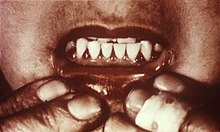Our website is made possible by displaying online advertisements to our visitors.
Please consider supporting us by disabling your ad blocker.
Scurvy
| Scurvy | |
|---|---|
| Other names | Moeller's disease, Cheadle's disease, scorbutus,[1] Barlow's disease, hypoascorbemia,[1] vitamin C deficiency |
 | |
| Scorbutic gums, a symptom of scurvy. The triangle-shaped areas between the teeth show redness of the gums. | |
| Specialty | Endocrinology |
| Symptoms | Weakness, feeling tired, changes to hair, sore arms and legs, gum disease, easy bleeding[1][2] |
| Causes | Lack of vitamin C[1] |
| Risk factors | Mental disorders, unusual eating habits, alcoholism, substance use disorder, intestinal malabsorption, dialysis,[2] voyages at sea (historic), being stuck adrift |
| Diagnostic method | Based on symptoms[2] |
| Treatment | Vitamin C supplements,[1] diet that contains fruit and vegetables (notably citrus) |
| Frequency | Rare (contemporary)[2] |
Scurvy is a deficiency disease (state of malnutrition) resulting from a lack of vitamin C (ascorbic acid).[1] Early symptoms of deficiency include weakness, fatigue, and sore arms and legs.[1][2] Without treatment, decreased red blood cells, gum disease, changes to hair, and bleeding from the skin may occur.[1][3] As scurvy worsens, there can be poor wound healing, personality changes, and finally death from infection or bleeding.[2]
It takes at least a month of little to no vitamin C in the diet before symptoms occur.[1][2] In modern times, scurvy occurs most commonly in people with mental disorders, unusual eating habits, alcoholism, and older people who live alone.[2] Other risk factors include intestinal malabsorption and dialysis.[2]
While many animals produce their vitamin C, humans, and a few others do not.[2] Vitamin C, an antioxidant, is required to make the building blocks for collagen, carnitine, and catecholamines, and assists the intestines in the absorption of iron from foods.[2][4][5] Diagnosis is typically based on outward appearance, X-rays, and improvement after treatment.[2]
Treatment is with vitamin C supplements taken by mouth.[1] Improvement often begins in a few days with complete recovery in a few weeks.[2] Sources of vitamin C in the diet include citrus fruit and a number of vegetables, including red peppers, broccoli, and tomatoes.[2] Cooking often decreases the residual amount of vitamin C in foods.[2]
Scurvy is rare compared to other nutritional deficiencies.[2] It occurs more often in the developing world in association with malnutrition.[2] Rates among refugees are reported at 5 to 45 percent.[6] Scurvy was described as early as the time of ancient Egypt, and historically it was a limiting factor in long-distance sea travel, often killing large numbers of people.[2][7] During the Age of Sail, it was assumed that 50 percent of the sailors would die of scurvy on a major trip.[8]
- ^ a b c d e f g h i j "Scurvy". GARD. 1 September 2016. Archived from the original on 26 January 2017. Retrieved 26 September 2016.
- ^ a b c d e f g h i j k l m n o p q r Agarwal, A; Shaharyar, A; Kumar, A; Bhat, MS; Mishra, M (June 2015). "Scurvy in pediatric age group - A disease often forgotten?". Journal of Clinical Orthopaedics and Trauma. 6 (2): 101–7. doi:10.1016/j.jcot.2014.12.003. PMC 4411344. PMID 25983516.
- ^ "Vitamin C". Office of Dietary Supplements. 11 February 2016. Archived from the original on 30 July 2017. Retrieved 18 July 2017.
- ^ Coffee, Carole J. (1999). Quick Look: Metabolism. Hayes Barton. p. 26. ISBN 1-59377-192-4.
- ^ "Vitamin C". Linus Pauling Institute. 2014-04-22. Archived from the original on 2018-09-16. Retrieved 2023-06-04.
- ^ Renzaho, Andre M. N. (2016). Globalisation, Migration and Health: Challenges and Opportunities. World Scientific. p. 94. ISBN 978-1-78326-889-4. Archived from the original on 8 September 2017.
- ^ Toler, Pamela D. (2012). Mankind: The Story of All of Us. Running Press. p. 296. ISBN 978-0762447176. Archived from the original on 8 September 2017.
- ^ Price, Catherine (2017). "The Age of Scurvy". Distillations. Vol. 3, no. 2. pp. 12–23. Archived from the original on January 24, 2021. Retrieved April 17, 2018.
Previous Page Next Page


